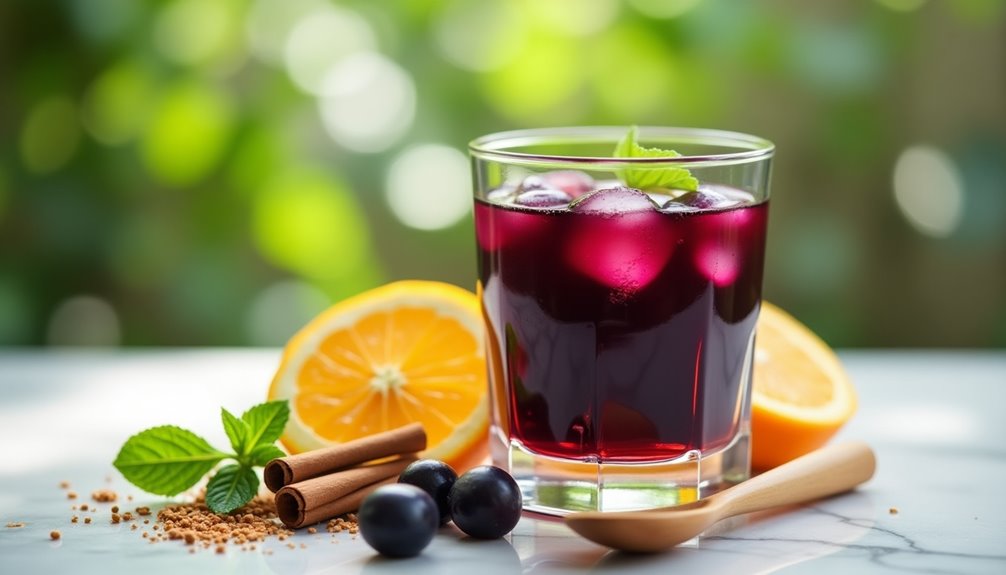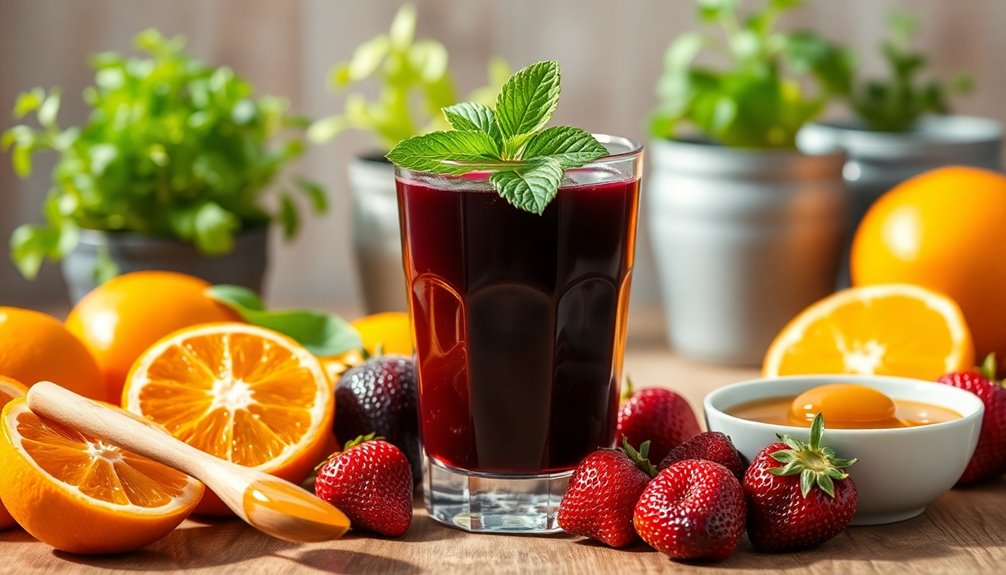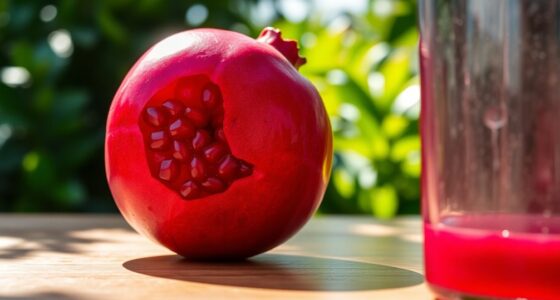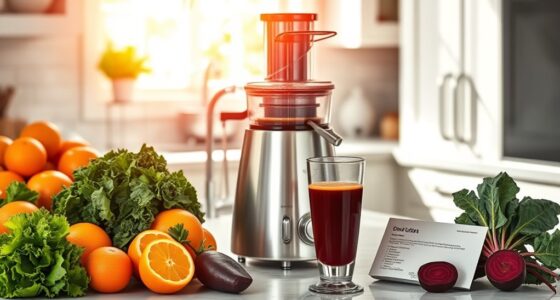To make prune juice taste better, mix it with sweeter fruit juices like apple or orange for a balanced flavor. You can also add a splash of cranberry or lemon juice for a refreshing tartness. Another option is to blend it into smoothies with yogurt and fruits to mask the strong flavor. For a warm treat, heat prune juice with cinnamon or ginger. If you enjoy fizz, try mixing it with club soda for a bubbly twist. There's more to explore!
Key Takeaways
- Mix prune juice with sweeter fruit juices like apple or orange for a balanced flavor.
- Add cranberry juice or lemon juice to introduce a refreshing tartness.
- Blend prune juice into smoothies with yogurt and fruits to mask its strong flavor.
- Serve prune juice heated with spices like cinnamon or ginger for a comforting drink.
- Combine prune juice with carbonated beverages for a lively and effervescent twist.

If you find prune juice a bit too strong for your taste, you're not alone. Many people struggle with the bold flavor of prune juice, even though it's packed with health benefits, particularly for relieving constipation. Fortunately, there are several pretty easy ways to improve the taste of prune juice, making it more enjoyable while still reaping its benefits.
One of the simplest methods to enhance the taste of prune juice is to mix it with sweeter fruit juices. For instance, combining prune juice with apple juice or orange juice can create a delightful flavor combination that masks the prune taste effectively. You can start with a 50-50 mix and adjust according to your preferences. The natural sweetness of apple and orange juice balances the stronger notes of prune juice beautifully, making it a treat rather than a chore to drink.
If you prefer a bit of tartness in your drink, consider adding cranberry juice or lemon juice to your prune juice. The tart and refreshing notes of these juices can provide a nice contrast to the sweetness and help elevate the overall flavor. You might find that just a splash of cranberry juice makes all the difference, giving you a refreshing drink that still provides the health benefits you'd expect from prune juice.
Another fun way to change up the flavor profile is by blending prune juice into smoothies. Mixing it with yogurt, bananas, or berries not only masks the taste of prune juice but also gives you a creamy texture that's hard to resist. You can create a delicious smoothie by combining a cup of prune juice with a banana, a handful of berries, and a scoop of yogurt. The result is a nutritious beverage that's not only tasty but also packs a punch when it comes to fiber and other essential nutrients.
If you're looking for something warm and comforting, consider serving prune juice heated with spices like cinnamon or ginger. Heating the juice can alter the flavor perception positively, making it taste like a warm spiced beverage rather than a typical juice. Just warm it gently on the stove and sprinkle in some spices. You'll have a soothing drink that can be especially nice on a chilly day.
Finally, if you enjoy a bit of fizz, try incorporating carbonated beverages like club soda or ginger ale into your prune juice. This adds a fun effervescence that can transform the drink into a lively concoction. Just mix equal parts prune juice and your chosen fizzy drink, and you've got a refreshing beverage that's easy to sip and enjoy.
With these tips, you can easily make prune juice taste better while still taking advantage of its many health benefits. Enjoy experimenting with different combinations to find what suits your palate best!
Frequently Asked Questions
What Can You Mix Prune Juice With to Make It Taste Better?
If you're looking to improve prune juice's taste, try mixing it with apple juice for a sweeter flavor.
Tart cranberry juice can provide a refreshing contrast, while sparkling water or ginger ale adds a fizzy finish.
A splash of lemon or lime juice will help neutralize its tartness, and blending it with orange juice not only masks the taste but also adds extra vitamins.
Experiment with these combinations to find what you enjoy the most!
What Is the Best Way to Drink Prune Juice?
Drinking prune juice is like embarking on a flavorful journey; it's all about finding what suits your taste.
You'll enjoy it best chilled or over ice, which can elevate its refreshing quality. Try mixing it with other juices or blending it into smoothies for a delicious twist.
Serving it warm, like with hot apple juice, can create a cozy experience. Garnish with fresh herbs or citrus to enhance both flavor and presentation.
How to Disguise the Taste of Prune Juice?
To disguise the taste of prune juice, try mixing it with stronger fruit juices like cranberry or apple. Additionally, you can enhance the flavor by adding a splash of lemon juice or a dash of cinnamon, which can complement the natural sweetness of the prune juice. If you’re looking for a refreshing drink, consider blending the prunes with ice to create a smoothie-like consistency. For those curious about how to prepare prune juice, simply blend pitted prunes with water, strain the mixture, and then sweeten or flavor it to your liking.
Adding a splash of citrus juice, like lemon or lime, can also help balance the flavor.
If you enjoy fizz, combine it with ginger ale or club soda for a refreshing twist.
You could even stir in yogurt or milk for creaminess.
Experimenting with serving it warm with spices might also enhance your experience.
Is There a Good Tasting Prune Juice?
Yes, there are good-tasting prune juices available! You can try brands like Sunsweet Prune D'Noir, which offers a sweeter, candy-like flavor without preservatives.
Mixing prune juice with stronger fruit juices like cranberry or apple can also enhance the taste. If you're feeling adventurous, blending it with fizzy drinks like ginger ale can add a refreshing twist.
Experimenting with spices or serving it warm might just surprise you with delightful flavors, too!
Conclusion
Incorporating these tips, you'll transform prune juice from a mundane potion into a delightful elixir worthy of a modern-day Apollo's feast. With a splash of citrus, a hint of spice, or a dash of sweetness, you'll discover flavors that dance on your palate. So, don't shy away from experimenting! Just like Odysseus faced trials on his journey, you too can conquer the challenge of making prune juice a refreshing part of your daily routine. Cheers!
Cindy thoroughly researches juicing trends, techniques, and recipes to provide readers with practical advice and inspiration. Her writing style is accessible, engaging, and designed to make complex concepts easy to understand. Cindy’s dedication to promoting the advantages of juicing shines through her work, empowering readers to make positive changes in their lives through the simple act of juicing.











